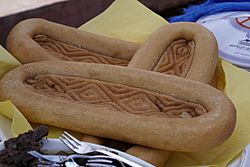Ul boov facts for kids

Heviin boov
|
|
| Alternative names | Kheviin boov |
|---|---|
| Type | Biscuit |
| Course | Dessert |
| Place of origin | Mongolia |
| Main ingredients | Sheep fat, flour, salt water, sugar, butter |
Heviin boov (Mongolian: ул боов), also known as Ul boov, is a special biscuit from Mongolia. It's made by stacking many layers on top of each other. The number of layers in a Heviin boov stack can show how important a family is. Each biscuit often has a unique design pressed into it using a wooden block. These designs are special to each family and are passed down through many generations. People usually serve Heviin boov with aaruul, a dried dairy product, placed between the layers or on top.
What Does Ul Boov Mean?
The name Ul boov means "shoe soles" in English language. This name comes from its shape, which can look a bit like the bottom of a shoe.
When Do Mongolians Eat Heviin Boov?
Mongolians traditionally prepare Heviin boov for their Lunar New Year celebration, called Tsagaan Sar. This holiday is a very important and big feast. Families start getting ready for Tsagaan Sar many days before it begins. Everyone, both men and women, works together to make lots of buuz (steamed dumplings) and Heviin boov. Heviin boov is served as a dessert and is also an important part of the holiday display.
Tsagaan Sar: A Special Celebration
Tsagaan Sar is a time for families to gather and celebrate new beginnings. It's a joyful holiday with lots of food, traditional clothes, and visits to elders. During a time in Mongolia's past, the government tried to stop people from celebrating Tsagaan Sar. They wanted to replace it with a different holiday. However, after 1990, people were able to celebrate Tsagaan Sar freely again, and it remains a cherished tradition.

